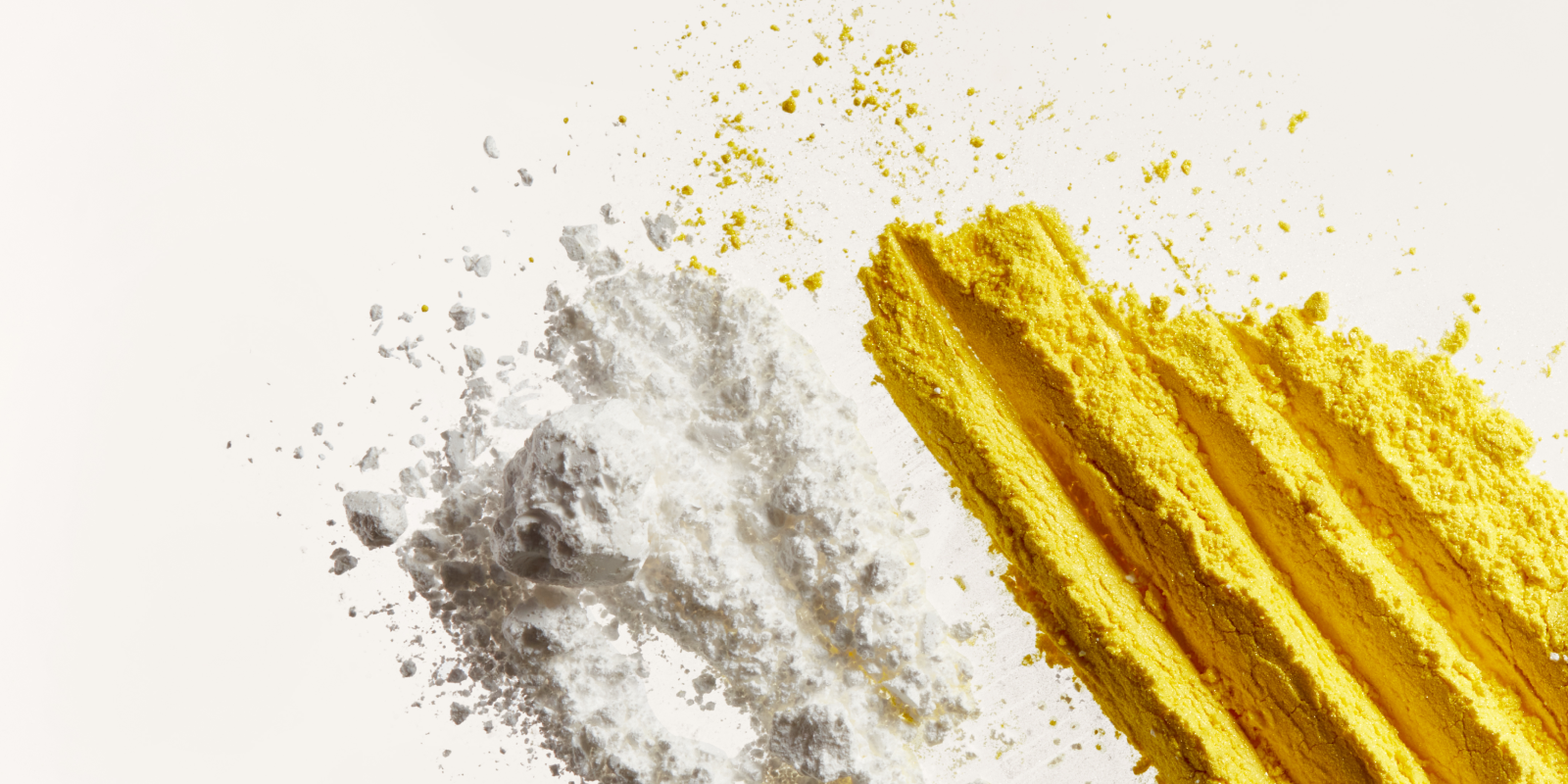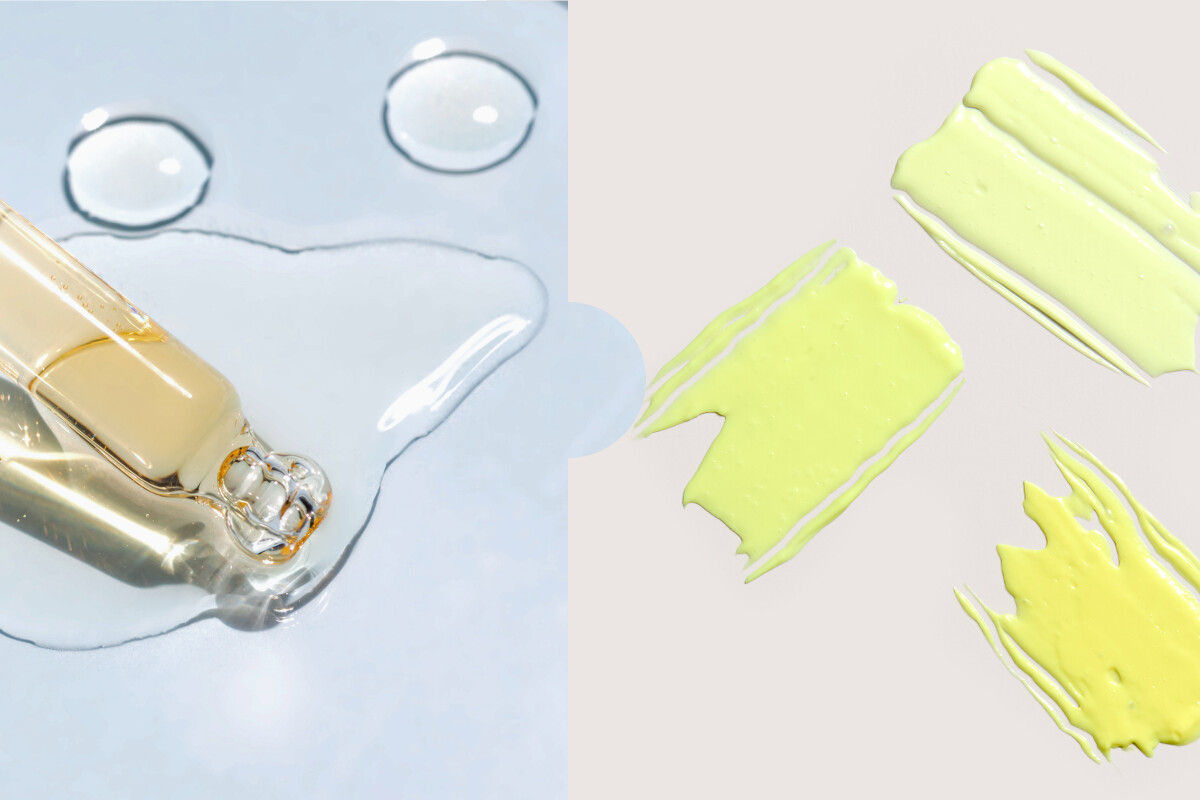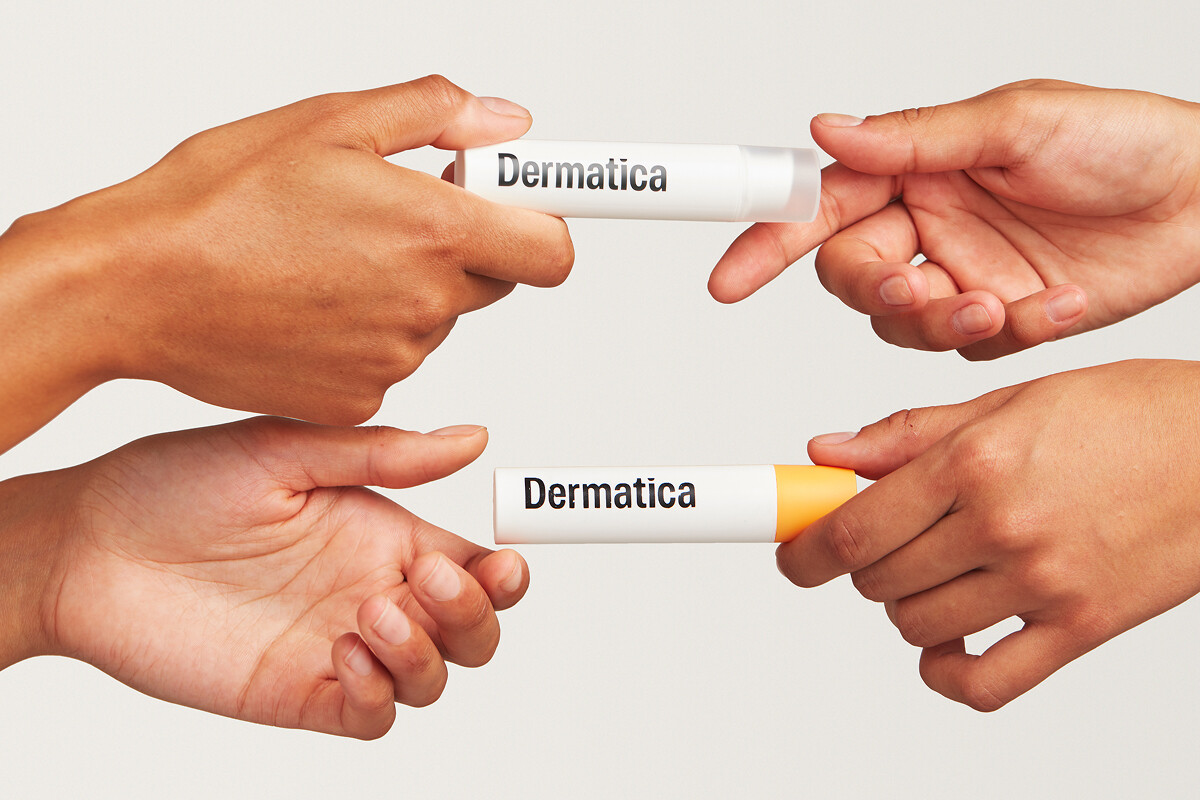If there’s one ingredient all skincare experts can agree on, it’s retinoids. These are chemical compounds that come from vitamin A — they are skin powerhouses and they find their way into many of the most effective anti-ageing and acne treatments.
Two retinoids you’ll hear us talk about are tretinoin and adapalene. But what’s the difference, and which one is right for you? Let’s take a look.
First, what’s a retinoid?
Retinoids are a group of chemicals derived from vitamin A. They’ve long been the go-to for treating acne and ageing, because they are so effective. ,
Retinoids come in many forms. Some feature as the active ingredient in over-the-counter skincare products, available in any pharmacy or supermarket. These include retinyl palmitate, retinol, and retinaldehyde (retinal). Retinol is the natural form of vitamin A that you can find in cosmetics, which needs to oxidise twice before it converts to the active form, known as retinoic acid. Retinal needs one step. When we look at retinoids that are on prescription such as tretinoin, this is actually retinoic acid which is the active molecule which can get to work on the skin.
Alternatively, there are more potent, prescription-strength retinoids — which you can get on prescription, or of course, from the dermatology experts at Dermatica.
All retinoids work in a similar way, by increasing cell turnover. This stops the build-up of skin cells, increases skin renewal and unclogs pores. Retinoids also have an anti-inflammatory effect, which can be especially helpful for some types of acne. They also help to stimulate collagen production, reverse fine lines caused by photoageing, and can lighten pigmentation due to their exfoliating effect.
Essentially, these hero ingredients can help deliver a smooth, clear complexion.
Tretinoin
Tretinoin, also known as retinoic acid, is the most widely-researched and potent retinoid. It’s been used to treat acne for at least four decades. It’s prescribed at different strengths, often starting as low as 0.015% and increasing to 0.05% as the skin adjusts.
What are the benefits of tretinoin?
Where do we start with this wonder ingredient? Tretinoin has been widely researched and shown many skin benefits in studies. It’s a great all-round anti-ager, and can bring about significant changes in the structure of your skin, affecting how it looks and feels. The proven benefits include a significant improvement in:
Fine lines
Pigmentation
Texture
Elasticity
All-in-all, tretinoin will help to reverse the signs of ageing, including natural, chronological changes as well as photoageing caused by sunlight.
Tretinoin also offers excellent benefits for acne. Studies have shown it effectively improves:,
Blackheads
Whiteheads
Papules (small bumps)
Pustules (pus-filled spots)
What are the side effects of tretinoin?
It’s effective, yes. But it can be associated with skin irritation when you start using it. Skin may become red or blotchy and flaky, and may burn or sting. This is called retinisation, and it’s really just a sign that the treatment is working, because it shows your skin is starting to exfoliate.
Everyone is different though, and if you don’t get any irritation, that doesn’t mean tretinoin isn’t effective for you.
The irritation will improve as your skin adjusts to the ingredients. And there are a few simple steps you can take to reduce this side-effect:
Prep your skin: Try using a barrier-boosting moisturiser for two weeks before starting treatment. Look for one containing niacinamide, panthenol, and tocopheryl acetate.
Start low and slow: We usually recommend the lowest dose to begin with, and suggest you only apply it twice a week. You can build up in frequency and strength as your skin adjusts.
Make a skincare sandwich: Apply moisturiser before and after your treatment.
Skip a day if you need to: You might need to give your skin a little break, and that’s fine. Wait until your skin has recovered and then re-introduce gradually.
Stick with it — this is strong stuff, but the results are worth it.
Adapalene
Adapalene is a relatively new kid on the retinoid block. It’s a synthetic version of vitamin A with a slightly different structure to tretinoin.
It has similar properties to tretinoin, but it’s a more stable chemical. This means it won’t lose its potency if exposed to sunlight, as tretinoin can. It also means adapalene can more easily be combined with other ingredients to combat acne, such as bacteria-flighting benzoyl peroxide, or clindamycin, an antibiotic.,
What are the benefits of adapalene?
There’s good evidence that adapalene can work wonders for acne. Many studies have compared it with tretinoin, and found that it’s just as effective, and in some studies even more so, for treating both inflammatory and non-inflammatory acne.
There is some evidence for its use as an anti-ageing tool too — it’s been shown to reduce pigmentation and improve wrinkles., But we need more studies in this area to understand its full potential.
What are the side effects of adapalene?
This is where adapalene may have the edge on tretinoin.
Multiple studies have shown that adapalene causes less skin irritation than tretinoin. This has been shown in several different strengths and formulations — even versus tretinoin at 0.025%, which is at the lower end of prescribed concentrations.
Which should I use?
Anti-ageing
If your aim is anti-ageing, tretinoin is your answer. There is currently more evidence for tretinoin than there is for adapalene when it comes to achieving younger-looking skin.
You may need to be prepared for the side effects of the retinisation process. But follow our advice, and you can minimise irritation. You can be fairly confident that you’ll achieve noticeably more youthful skin if you stick with it.
As evidence builds for adapalene, this may become the first choice for anti-ageing. But until then, we’ll suggest you try tretinoin first. You may need to switch to adapalene if your skin just can’t tolerate tretinoin.
Acne
If you’re looking for an effective acne solution, adapalene is the active ingredient for you. There are a few reason why this is the one to go for:
There’s plenty of evidence that it’s effective against acne, and it may work faster than tretinoin
It results in less irritation than tretinoin
It’s more stable, which means it can be combined with other acne-busting ingredients, such as clindamycin or benzoyl peroxide
What should I do next?
If you’re looking for effective acne or anti-ageing ingredients, retinoids can help. Adapalene and tretinoin are potent treatments, which need to be prescribed and monitored carefully..
Thankfully, Dermatica makes the process easy. We offer immediate access to an expert dermatology team who offer personalised evidence-based prescription medicines to combat acne and fight ageing. Your treatment is delivered to your door, and you’ll have experts on hand to ask questions whenever you need.
So there’s nothing to slow your journey towards the clear, youthful skin you want.
References
1. Thielitz, A., Abdel-Naser, M.B., Fluhr, J.W., Zouboulis, C.C. and Gollnick, H. (2008), Topical retinoids in acne – an evidence-based overview. JDDG: Journal der Deutschen Dermatologischen Gesellschaft, 6: 1023-1031. https://doi.org/10.1111/j.1610-0387.2008.06741.x
2. Mukherjee S, Date A, Patravale V, Korting HC, Roeder A, Weindl G. Retinoids in the treatment of skin aging: an overview of clinical efficacy and safety. Clin Interv Aging. 2006;1(4):327-48. doi: 10.2147/ciia.2006.1.4.327. PMID: 18046911; PMCID: PMC2699641.
3. Thielitz, A., Abdel-Naser, M.B., Fluhr, J.W., Zouboulis, C.C. and Gollnick, H. (2008), Topical retinoids in acne – an evidence-based overview. JDDG: Journal der Deutschen Dermatologischen Gesellschaft, 6: 1023-1031. https://doi.org/10.1111/j.1610-0387.2008.06741.x
4. Thielitz, A., Abdel-Naser, M.B., Fluhr, J.W., Zouboulis, C.C. and Gollnick, H. (2008), Topical retinoids in acne – an evidence-based overview. JDDG: Journal der Deutschen Dermatologischen Gesellschaft, 6: 1023-1031. https://doi.org/10.1111/j.1610-0387.2008.06741.x
5. Piskin S, Uzunali E. A review of the use of adapalene for the treatment of acne vulgaris. Ther Clin Risk Manag. 2007 Aug;3(4):621-4. PMID: 18472984; PMCID: PMC2374937
6. Mukherjee S, Date A, Patravale V, Korting HC, Roeder A, Weindl G. Retinoids in the treatment of skin aging: an overview of clinical efficacy and safety. Clin Interv Aging. 2006;1(4):327-48. doi: 10.2147/ciia.2006.1.4.327. PMID: 18046911; PMCID: PMC2699641.
7. Mukherjee S, Date A, Patravale V, Korting HC, Roeder A, Weindl G. Retinoids in the treatment of skin aging: an overview of clinical efficacy and safety. Clin Interv Aging. 2006;1(4):327-48. doi: 10.2147/ciia.2006.1.4.327. PMID: 18046911; PMCID: PMC2699641.
8. Zaenglein AL, Pathy AL, Schlosser BJ, Alikhan A, Baldwin HE, Berson DS, et al. Guidelines of care for the management of acne vulgaris. Journal of the American Academy of Dermatology. 2016;74(5):945-73. e33.
9. Krishnan G. Comparison of two concentrations of tretinoin solution in the topical treatment of acne vulgaris. The Practitioner. 1976;216(1291):106-9.
10. Piskin S, Uzunali E. A review of the use of adapalene for the treatment of acne vulgaris. Ther Clin Risk Manag. 2007 Aug;3(4):621-4. PMID: 18472984; PMCID: PMC2374937
11. Mukherjee S, Date A, Patravale V, Korting HC, Roeder A, Weindl G. Retinoids in the treatment of skin aging: an overview of clinical efficacy and safety. Clin Interv Aging. 2006;1(4):327-48. doi: 10.2147/ciia.2006.1.4.327. PMID: 18046911; PMCID: PMC2699641.
12. Draelos, Z.D., K.D. Ertel, and C.A. Berge, Facilitating facial retinization through barrier improvement. Cutis, 2006. 78(4): p. 275-281.
13. Piskin S, Uzunali E. A review of the use of adapalene for the treatment of acne vulgaris. Ther Clin Risk Manag. 2007 Aug;3(4):621-4. PMID: 18472984; PMCID: PMC2374937
14. Jain S. Topical tretinoin or adapalene in acne vulgaris: an overview. Journal of Dermatological Treatment (2004) 15, 200–207
15. Jain S. Topical tretinoin or adapalene in acne vulgaris: an overview. Journal of Dermatological Treatment (2004) 15, 200–207
16. Zaenglein AL, Pathy AL, Schlosser BJ, Alikhan A, Baldwin HE, Berson DS, et al. Guidelines of care for the management of acne vulgaris. Journal of the American Academy of Dermatology. 2016;74(5):945-73. e33.
17. Ellis C, Millikan L, Smith E, Chalker D, Swinyer L, Katz I, et al. Comparison of adapalene 0·1% solution and tretinoin 0·025% gel in the topical treatment of acne vulgaris. 1998
18. Bagatin, E., Gonçalves, H.d.S., Sato, M. et al. Comparable efficacy of adapalene 0.3% gel and tretinoin 0.05% cream as treatment for cutaneous photoaging. Eur J Dermatol 28, 343–350 (2018). https://doi.org/10.1684/ejd.2018.3320
19. Kang S, Goldfarb MT, Weiss JS, Metz RD, Hamilton TA, Voorhees JJ, et al. Assessment of adapalene gel for the treatment of actinic keratoses and lentigines: a randomized trial. Journal of the American Academy of Dermatology. 2003;49(1):83-90.
20. Jain S. Topical tretinoin or adapalene in acne vulgaris: an overview. Journal of Dermatological Treatment (2004) 15, 200–207
21. Shalita, A., et al., A comparison of the efficacy and safety of adapalene gel 0.1% and tretinoin gel 0.025% in the treatment of acne vulgaris: a multicenter trial. Journal of the American Academy of Dermatology, 1996. 34(3): p. 482-485.
22. Mukherjee S, Date A, Patravale V, Korting HC, Roeder A, Weindl G. Retinoids in the treatment of skin aging: an overview of clinical efficacy and safety. Clin Interv Aging. 2006;1(4):327-48. doi: 10.2147/ciia.2006.1.4.327. PMID: 18046911; PMCID: PMC2699641.
23. Cunliffe W, Poncet M, Loesche C, Verschoore M. A comparison of the efficacy and tolerability of adapalene 0.1% gel versus tretinoin 0.025% gel in patients with acne vulgaris: a meta-analysis of five randomized trials. 1998.
24. Jain S. Topical tretinoin or adapalene in acne vulgaris: an overview. Journal of Dermatological Treatment (2004) 15, 200–207
25. Irby CE, Yentzer BA, Feldman SR. A review of adapalene in the treatment of acne vulgaris. Journal of Adolescent Health. 2008;43(5):421-4.
Jane McQueen
Jane McQueen is a medical copywriter with over 15 years of experience in health content. She’s worked across all healthcare sectors, creating evidence-based content on topics from skincare to mental health. She has a life sciences background, with a degree in physiology and a PgDip in public health.
Dr Catriona Maybury
Dr Catriona Maybury is a Consultant Dermatologist, working as Medical Lead for Dermatica and at St George’s Hospital in London. Catriona completed her specialty training at St John’s Institute of Dermatology in London. Catriona has a special interest in medical dermatology, completing a PhD in liver fibrosis amongst psoriasis patients at King’s College London. Catriona is a certified coach and worked as Dermatology Section Editor for the British Medical Journal.




